Unplugged: Holiday Guide 2015
 Give the gift of face to face time with a boardgame. It’s time once again for me to preach to the masses on the greatness of boardgaming. Nothing beats the social aspect of in-person gaming with friends. Last year’s run-down remains a great list of recommended games. Here again are some great examples of boardgames to get you and your family gaming. You might not find all these titles at your local mega-mart but many can be found online or in a friendly local game store. Some may argue $50+ boardgames are expensive, but compare that to videogaming (and where multiple copies are required for multiplayer play) and the economics of boardgaming shows their true value. Good boardgames are timeless, just as good today as they will be years in the future. They will provide many more hours of entertainment than most video games. In that vein, feel free to delve into some past year’s guides for 2013, 2012, 2010, and 2009.
Give the gift of face to face time with a boardgame. It’s time once again for me to preach to the masses on the greatness of boardgaming. Nothing beats the social aspect of in-person gaming with friends. Last year’s run-down remains a great list of recommended games. Here again are some great examples of boardgames to get you and your family gaming. You might not find all these titles at your local mega-mart but many can be found online or in a friendly local game store. Some may argue $50+ boardgames are expensive, but compare that to videogaming (and where multiple copies are required for multiplayer play) and the economics of boardgaming shows their true value. Good boardgames are timeless, just as good today as they will be years in the future. They will provide many more hours of entertainment than most video games. In that vein, feel free to delve into some past year’s guides for 2013, 2012, 2010, and 2009.
For each game I’ve provided the number of players, retail price, and expected time for one game. Note that often these games can be found for 20-40% less than the MSRP.
Kids
Games suitable for kids old enough to sit still and play, but contain enough interesting activity to entertain adults.
Yeti in my Spaghetti (2+p, $18, 10 min)
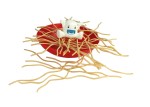 A fun little game that conjures up the vibe of Don’t Break the Ice. Here a little plastic guy hangs over a bowl supported only by plastic spaghetti noodles. While it may seem straightforward at first glance, the zig-zag noodles make the figure’s balance unpredictable and prevent a straightforward removal of a single strand.
A fun little game that conjures up the vibe of Don’t Break the Ice. Here a little plastic guy hangs over a bowl supported only by plastic spaghetti noodles. While it may seem straightforward at first glance, the zig-zag noodles make the figure’s balance unpredictable and prevent a straightforward removal of a single strand.
Loopin’ Chewie (3p, $26, 15min)
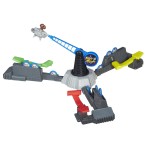 Loopin’ Louie is a classic game where an airplane on the tip of a lever is moved in a circle by a central motor. Players are given a little flipper with which to pop the airplane up into the air. Fail to do so when it passes by and it will knock one of your tokens off your station. Lose all your tokens and you’re out of the game. Loopin’ Chewie is just a variation on this hilarious (for all ages) game. In addition to the Star Wars theme, Loopin’ Chewie has three players instead of four. This makes it a great game for three players, where Loopin’ Louie serves better for 2 or 4.
Loopin’ Louie is a classic game where an airplane on the tip of a lever is moved in a circle by a central motor. Players are given a little flipper with which to pop the airplane up into the air. Fail to do so when it passes by and it will knock one of your tokens off your station. Lose all your tokens and you’re out of the game. Loopin’ Chewie is just a variation on this hilarious (for all ages) game. In addition to the Star Wars theme, Loopin’ Chewie has three players instead of four. This makes it a great game for three players, where Loopin’ Louie serves better for 2 or 4.
Chopstick Dexterity MegaChallenge 3000 (2-3p, $35, 15min)
 This is nothing but a plastic bowl, a bunch of little colored shapes, and three sets of chopsticks. However, the game is so much more than the sum of its parts. Players flip over a card and then do “battle” with their chopsticks in order to be the first to gather the appropriate items out of the bowl. You can play the game via the “light” path, but more often players will choose the dark side, where chopstick vs chopstick interactions are not only encouraged, but the norm. One needs a passable talent with chopsticks, but a few games will quickly suffice. The game is as fun as its name, I can’t give it better praise than that.
This is nothing but a plastic bowl, a bunch of little colored shapes, and three sets of chopsticks. However, the game is so much more than the sum of its parts. Players flip over a card and then do “battle” with their chopsticks in order to be the first to gather the appropriate items out of the bowl. You can play the game via the “light” path, but more often players will choose the dark side, where chopstick vs chopstick interactions are not only encouraged, but the norm. One needs a passable talent with chopsticks, but a few games will quickly suffice. The game is as fun as its name, I can’t give it better praise than that.
Party
The more, the merrier! Here are a few games that can accommodate at least 6 players and, unlike some games, tend to be more fun with more players.
Duplik (3-10p, $20 , 45 min)
 In Duplik, the active player describes a (often a bit strange) picture shown on a card, while all the other players attempt to draw what is described. Once the time is up, players pass their drawing to their neighbor. The active player then lists ten criteria (unknown by anyone up to that point) for which each drawing is evaluated (players can earn points for things such as correct placement on the page, correct relative sizes, among other attributes.) The active player scores a point for each of the ten criteria satisfied by at least one of the players. A great party game that doesn’t rely (much) on luck or trivia knowledge. Bonus points for any zany drawing that is saved and posted in a place of honor on the fridge.
In Duplik, the active player describes a (often a bit strange) picture shown on a card, while all the other players attempt to draw what is described. Once the time is up, players pass their drawing to their neighbor. The active player then lists ten criteria (unknown by anyone up to that point) for which each drawing is evaluated (players can earn points for things such as correct placement on the page, correct relative sizes, among other attributes.) The active player scores a point for each of the ten criteria satisfied by at least one of the players. A great party game that doesn’t rely (much) on luck or trivia knowledge. Bonus points for any zany drawing that is saved and posted in a place of honor on the fridge.
Terra (2-6p <or 2-6 teams>, $50, 60 min)
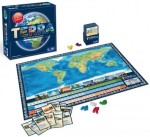 Finally, a trivia game where being close counts. A sequel of Fauna (based on animal questions), Terra focuses on questions about the earth: geography, landmarks, and other places of interest. It contains questions like “how long is the golden gate bridge”, “where is evidence of a yeti supposedly found”, and “how many statues are on Easter Island.” Players take turns placing their markers onto the board to indicate their guess. They don’t have to know the precise answer, but score points for being correct and (fewer points) for being nearly correct. While Wits and Wagers is usually my go-to game for trivia, Terra makes a better game when one only has a few players.
Finally, a trivia game where being close counts. A sequel of Fauna (based on animal questions), Terra focuses on questions about the earth: geography, landmarks, and other places of interest. It contains questions like “how long is the golden gate bridge”, “where is evidence of a yeti supposedly found”, and “how many statues are on Easter Island.” Players take turns placing their markers onto the board to indicate their guess. They don’t have to know the precise answer, but score points for being correct and (fewer points) for being nearly correct. While Wits and Wagers is usually my go-to game for trivia, Terra makes a better game when one only has a few players.
Codenames (2-8p, $20, 20 min)
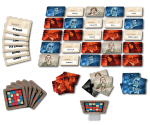 A 5×5 grid of word cards are placed out on the table. Each team has one spymaster who is aware of which words match which team. The two spymasters take turns giving one word or number answers to their team. The team then points out the card or cards on the table they think match that clue. Each card selected reveals who owns that card (it could be theirs, the opponents, or neither.) If a team guesses correctly, they get to take another turn. However, there is also an assassin card on the table. Any team picking that card will lose the game instantly. This means it is important to give good clues about one’s own cards but also make sure you aren’t giving clues for the opponents’ cards. It is a fun deduction game with easy to learn rules. A lot depends on the quality of the spymaster, but it is fun even in defeat.
A 5×5 grid of word cards are placed out on the table. Each team has one spymaster who is aware of which words match which team. The two spymasters take turns giving one word or number answers to their team. The team then points out the card or cards on the table they think match that clue. Each card selected reveals who owns that card (it could be theirs, the opponents, or neither.) If a team guesses correctly, they get to take another turn. However, there is also an assassin card on the table. Any team picking that card will lose the game instantly. This means it is important to give good clues about one’s own cards but also make sure you aren’t giving clues for the opponents’ cards. It is a fun deduction game with easy to learn rules. A lot depends on the quality of the spymaster, but it is fun even in defeat.
Family
As your family gets older, they’ll have more fun with games with a bit more “punch”. Games in this category are playable by most any age level (so even the young ones can participate) but have enough strategy so that the older players have a chance to use strategy to increase their chances of winning.
Favor of the Pharaoh (2-4p, $60, 60 min)
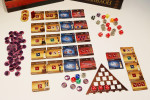 In Favor of the Pharaoh, players take turns rolling dice, trying to form specific combinations. Similar to Yahtzee, a player starts with three dice and rolls them, setting aside at least one die and rerolling the rest until all dice are set aside. A matching combination grants a player a special powers, which can be used for the rest of the game. Powers might include granting additional dice or adjusting the value of dice before setting them aside. In this way, players gain more and more powers, granting more dice or abilities, until someone is able to roll seven of a kind. This triggers the end game where every player tries to roll the “best” set of matching dice (eight twos beat seven sixes but lose to eight fours, etc…) Sometimes there is very little strategy to a turn, with only one choice the clear favorite, but other times players have the chance to take one of several powers which can affect their later play. While the game is similar to some older games of this type (To Court the King, for instance), Favor of the Pharaoh has two things going for it. First, the game has an entire section of powers that are powerful, one-use abilities. When used at the proper moment, they can have a significant effect on the outcome. Second, the game has variability. For every dice combination, there are several options from which to choose while setting up the game. While the game will certainly favor someone who has a few “lucky” rolls, over time, wise play will still grant an advantage.
In Favor of the Pharaoh, players take turns rolling dice, trying to form specific combinations. Similar to Yahtzee, a player starts with three dice and rolls them, setting aside at least one die and rerolling the rest until all dice are set aside. A matching combination grants a player a special powers, which can be used for the rest of the game. Powers might include granting additional dice or adjusting the value of dice before setting them aside. In this way, players gain more and more powers, granting more dice or abilities, until someone is able to roll seven of a kind. This triggers the end game where every player tries to roll the “best” set of matching dice (eight twos beat seven sixes but lose to eight fours, etc…) Sometimes there is very little strategy to a turn, with only one choice the clear favorite, but other times players have the chance to take one of several powers which can affect their later play. While the game is similar to some older games of this type (To Court the King, for instance), Favor of the Pharaoh has two things going for it. First, the game has an entire section of powers that are powerful, one-use abilities. When used at the proper moment, they can have a significant effect on the outcome. Second, the game has variability. For every dice combination, there are several options from which to choose while setting up the game. While the game will certainly favor someone who has a few “lucky” rolls, over time, wise play will still grant an advantage.
Survive: Space Attack (2-4p, $50, 60 min)
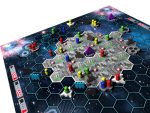 Survive: Space Attack challenges players to maneuver their astronaut crew out of a space station to safety before the station falls completely apart. To make matters worse, there are aliens floating around just outside the station, ready to gobble up anyone unlucky enough to cross their path. Thankfully, there are a few laser turrets on board which can help (a little) with the alien invasion. On a turn, a player gets to move their people around, remove one of the spaceship tiles, and also gets the chance to move around one of the alien creatures. Removing tiles not only blocks or hinders one’s opponents but removed tiles also grant a player one-use powers than can be used later in the game. Players attempt to use escape pods, fighters, or simply drift their way to one of several exit jump points. One station tile reveals a core breach and when it is removed the game ends. Players score points for their escapees as well as bonus points for each different escape route used. Survive: Space Attack plays out as a fun little game as players can focus on several methods of escaping. Do you spend your time trying to make things worse for your opponents, or make a beeline to escape before your opponents make your life worse.
Survive: Space Attack challenges players to maneuver their astronaut crew out of a space station to safety before the station falls completely apart. To make matters worse, there are aliens floating around just outside the station, ready to gobble up anyone unlucky enough to cross their path. Thankfully, there are a few laser turrets on board which can help (a little) with the alien invasion. On a turn, a player gets to move their people around, remove one of the spaceship tiles, and also gets the chance to move around one of the alien creatures. Removing tiles not only blocks or hinders one’s opponents but removed tiles also grant a player one-use powers than can be used later in the game. Players attempt to use escape pods, fighters, or simply drift their way to one of several exit jump points. One station tile reveals a core breach and when it is removed the game ends. Players score points for their escapees as well as bonus points for each different escape route used. Survive: Space Attack plays out as a fun little game as players can focus on several methods of escaping. Do you spend your time trying to make things worse for your opponents, or make a beeline to escape before your opponents make your life worse.
Catan: Traveler – Compact Edition (2-4p, $45, 60min)
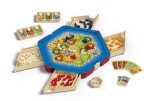 If you are unaware of Catan (it used to be called Settlers of Catan), it is a great little family-weight game. Players place their settlements and roads onto a board of hexagonal tiles (rearranged a new way each game) and then dice are rolled every turn. Depending on the number rolled, players gain resource cards with which they can build new roads and settlements. These, in turn, provide access to additional resources and the process is repeated until one player accumulates the required number of victory points. Considered one of the earliest “modern” boardgames, the game has several great things going for it. First, there is no direct player conflict. Players build items onto the central board but cannot take over or destroy their opponent’s items. Second, players are encouraged to trade resources in order to complete specific sets needed to build more roads or settlements. This keeps players involved even on other player’s turns. This new edition of the title is a great portable version of the game. The game is contained in a plastic board that is folded (and locked) in half to make a little portable suitcase. The game bits (settlement pieces, roads, cards, etc…) are all stored in handy drawers within the board itself. The board is made of a sturdy hard plastic suitable for regular use, but since it is hard plastic the case can chip and break if it is dropped onto a hard surface. If you are unfamiliar with the game, it is a great title and this version is great for home or for portable play.
If you are unaware of Catan (it used to be called Settlers of Catan), it is a great little family-weight game. Players place their settlements and roads onto a board of hexagonal tiles (rearranged a new way each game) and then dice are rolled every turn. Depending on the number rolled, players gain resource cards with which they can build new roads and settlements. These, in turn, provide access to additional resources and the process is repeated until one player accumulates the required number of victory points. Considered one of the earliest “modern” boardgames, the game has several great things going for it. First, there is no direct player conflict. Players build items onto the central board but cannot take over or destroy their opponent’s items. Second, players are encouraged to trade resources in order to complete specific sets needed to build more roads or settlements. This keeps players involved even on other player’s turns. This new edition of the title is a great portable version of the game. The game is contained in a plastic board that is folded (and locked) in half to make a little portable suitcase. The game bits (settlement pieces, roads, cards, etc…) are all stored in handy drawers within the board itself. The board is made of a sturdy hard plastic suitable for regular use, but since it is hard plastic the case can chip and break if it is dropped onto a hard surface. If you are unfamiliar with the game, it is a great title and this version is great for home or for portable play.
Family Strategy Games
These are great games for most families – or a group of adults looking for a medium-weight game to play casually around the table to end an evening. These are a notch up in complexity kid’s or party games, but are simple enough for teens or preteens to enjoy.
Pandemic Legacy (2-4p, $70, 60 min)
 Pandemic is a great cooperative game where players use their own special powers in coordination in order to prevent diseases from spreading and taking over the world. Players all lose or win as a single team. On each turn a player can take a few actions (collect cards, remove disease cubes, move around, etc…) and then must reveal a new location for disease cubes to appear. Too many cubes in one place causes an “epidemic” to occur, spreading even more cubes around the board. Players race to complete sets of cards to “cure” each disease while simultaneously fending off the spread of cubes on the board. Pandemic Legacy takes this great co-op game and makes it into a “Legacy” type game, a game designed to be played several times. The “trick” of the Legacy system is that the game changes every time it is played. New cards are added, some cards may be removed, player powers might be increased, and even the game board itself can be permanently changed. The goal is to complete twelve “months” (successful games) to complete the game. Whereas Pandemic is a fun little game, making it evolve and change with each play creates an ongoing story-arc that brings a gaming group together with a shared experience unique to their own group.
Pandemic is a great cooperative game where players use their own special powers in coordination in order to prevent diseases from spreading and taking over the world. Players all lose or win as a single team. On each turn a player can take a few actions (collect cards, remove disease cubes, move around, etc…) and then must reveal a new location for disease cubes to appear. Too many cubes in one place causes an “epidemic” to occur, spreading even more cubes around the board. Players race to complete sets of cards to “cure” each disease while simultaneously fending off the spread of cubes on the board. Pandemic Legacy takes this great co-op game and makes it into a “Legacy” type game, a game designed to be played several times. The “trick” of the Legacy system is that the game changes every time it is played. New cards are added, some cards may be removed, player powers might be increased, and even the game board itself can be permanently changed. The goal is to complete twelve “months” (successful games) to complete the game. Whereas Pandemic is a fun little game, making it evolve and change with each play creates an ongoing story-arc that brings a gaming group together with a shared experience unique to their own group.
Cthulhu Realms (2-4, $20, 30min)
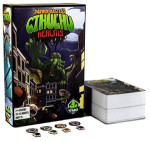 Cthulhu Realms is a tweaked and rethemed version of Star Realms, a highly recommended deckbuilder from last year. A deckbuilder is a card game where players begin the game with a small deck of cards and slowly accumulate new ones into their deck, reshuffling their deck when they run out of a draw pile. In this way, players accumulate more and more powerful cards as the game goes on. In Cthulhu Realms (as in Star Realms), cards provide money (to buy other cards) as well as attack values – which are used to attack one’s’ opponent. Cards can focus on providing more money, stronger attacks, some defensive abilities, or a mixture of all of them. Cthulhu Realms takes the best of Star Realms and streamlines the game to make it a tighter game. In Chtulhu Realms, there are fewer “suits” of cards, which mean the colors in the game have a higher likelihood of appearing at the same time and providing synergistic powers. If you enjoy deckbuilders, this is a fun little game (portable and inexpensive.) If the theme isn’t a problem (the spooky/scary Cthulhu mythos), I consider Cthulhu Realms to be a tighter, more interesting game. Due to its recent expansions, Star Realms is better for players who want wider variety in their games.
Cthulhu Realms is a tweaked and rethemed version of Star Realms, a highly recommended deckbuilder from last year. A deckbuilder is a card game where players begin the game with a small deck of cards and slowly accumulate new ones into their deck, reshuffling their deck when they run out of a draw pile. In this way, players accumulate more and more powerful cards as the game goes on. In Cthulhu Realms (as in Star Realms), cards provide money (to buy other cards) as well as attack values – which are used to attack one’s’ opponent. Cards can focus on providing more money, stronger attacks, some defensive abilities, or a mixture of all of them. Cthulhu Realms takes the best of Star Realms and streamlines the game to make it a tighter game. In Chtulhu Realms, there are fewer “suits” of cards, which mean the colors in the game have a higher likelihood of appearing at the same time and providing synergistic powers. If you enjoy deckbuilders, this is a fun little game (portable and inexpensive.) If the theme isn’t a problem (the spooky/scary Cthulhu mythos), I consider Cthulhu Realms to be a tighter, more interesting game. Due to its recent expansions, Star Realms is better for players who want wider variety in their games.
Dimension (1-4p, $50, 30 min)
 I’m not normally a fan of abstract games, and at first blush the pretty colored balls of Dimension lead one to believe it is an abstract game. However, at heart, the game is a competitive group puzzle. Players are given three spheres of each of the five colors and must stack them to form a pyramid according to set rules. Each round, six rule cards are laid out and players attempt to build as large a pile as possible without breaking any of the rules. Examples of rules include: you can only use 2 orange balls, no blue and white balls can be touching, you have to have more orange balls than black balls, etc… Players have a limited time to build as large a formation as possible. Once time runs out, players score a point for each ball used in their structure, lose two points for each broken rule, and gain a small bonus for using at least one of each of the five colors. The game does require a little bit of spatial skills, but as it isn’t a directly competitive game players can enjoy it as something of a group solitaire puzzle. Some players may have a knack for the game, but there is plenty of room for everyone to enjoy the joys of a nice score and the frustration of finding out you just broke three rules in one round.
I’m not normally a fan of abstract games, and at first blush the pretty colored balls of Dimension lead one to believe it is an abstract game. However, at heart, the game is a competitive group puzzle. Players are given three spheres of each of the five colors and must stack them to form a pyramid according to set rules. Each round, six rule cards are laid out and players attempt to build as large a pile as possible without breaking any of the rules. Examples of rules include: you can only use 2 orange balls, no blue and white balls can be touching, you have to have more orange balls than black balls, etc… Players have a limited time to build as large a formation as possible. Once time runs out, players score a point for each ball used in their structure, lose two points for each broken rule, and gain a small bonus for using at least one of each of the five colors. The game does require a little bit of spatial skills, but as it isn’t a directly competitive game players can enjoy it as something of a group solitaire puzzle. Some players may have a knack for the game, but there is plenty of room for everyone to enjoy the joys of a nice score and the frustration of finding out you just broke three rules in one round.
Serious Gamer
These are games for the more serious boardgamer. These have a few more rules and take a bit longer to play. However, they can be the most satisfying games to play for those willing to spend the time sitting at the table. While there are still quite a few games for me to check out, I haven’t found many new games this year that caught my fancy. Here are a couple that are new-ish ones that I can highly recommend. The price point may scare you, but they will provide many hours of enjoyment and can often be found at a bit of a discount.
Hyperborea (2-6p, $100, 90 min) *25 min/player
 This strange little game has a bit of everything. Played over a hexagonal setup of hexagons, players earn points from many different avenues including eliminating other armies, taking control of areas, researching special power cards, and accumulating action cubes of six different colors. In what some term a “bag building” game, players accumulate colored cubes in a personal bag of cubes. One then draws three cubes out of the bag every turn. These cubes are then placed on a personal action board (or a special power card previously obtained.) When an entire line of cubes is filled on your card, you can take the associated action. The color of the cubes dictate where they will fit on the board – green cubes tend to give you movement while red cubes let you attack in some way. Thus, the line containing a red and green cube track grants a player the ability to move an army figure on the board one square and attack an opponent (in either order.) I enjoy the game because of its variety. No one focus is a guarantee to win the game. Players can win using many different strategies. To make it even more unique, the six player colors can be used with special abilities that tend to emphasize cubes of their own color. (Red starts with a bit more combat ability, green with more movement, etc…) The game can take up to six players (one for each color) and it does run just about 25 minutes per player. Thus, I prefer it with less than five players as it can take quite a bit of time. The different personalities of each color side and the many strategies available keep the game fresh over many plays.
This strange little game has a bit of everything. Played over a hexagonal setup of hexagons, players earn points from many different avenues including eliminating other armies, taking control of areas, researching special power cards, and accumulating action cubes of six different colors. In what some term a “bag building” game, players accumulate colored cubes in a personal bag of cubes. One then draws three cubes out of the bag every turn. These cubes are then placed on a personal action board (or a special power card previously obtained.) When an entire line of cubes is filled on your card, you can take the associated action. The color of the cubes dictate where they will fit on the board – green cubes tend to give you movement while red cubes let you attack in some way. Thus, the line containing a red and green cube track grants a player the ability to move an army figure on the board one square and attack an opponent (in either order.) I enjoy the game because of its variety. No one focus is a guarantee to win the game. Players can win using many different strategies. To make it even more unique, the six player colors can be used with special abilities that tend to emphasize cubes of their own color. (Red starts with a bit more combat ability, green with more movement, etc…) The game can take up to six players (one for each color) and it does run just about 25 minutes per player. Thus, I prefer it with less than five players as it can take quite a bit of time. The different personalities of each color side and the many strategies available keep the game fresh over many plays.
El Grande Big Box (2-5p, $90, 90 min)
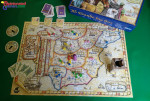 A classic area-control game, El Grande is now back in a “big box” edition. A current trend in boardgames is to release old classics with all their available expansions in one “big box.” El Grande was released in the mid-90s, it won many awards the year after Settlers of Catan appeared on the scene. While Catan is still a perennial favorite, I prefer the slightly deeper play of El Grande. Players place their pieces (caballeros) onto the game board in various areas in order to secure a majority. The game is played over nine rounds, with a scoring phase after every three rounds. When scoring, players can gain points for having the most or second most pieces in a particular area. Thus, one can vie for the majority in a few areas or go for second or third in many. Beyond the simple area majority, there are several factors that make the game unique. First, rather than one set of pieces, players control two groups. One is set aside for later use (the provinces), while the other group (the court) can be placed onto the board. Players must sacrifice turn order in order to increase the pieces in their court. Second, there is a special spot on the board occupied by a large, physical castillo (tower.) Rather than adding directly to an area, players can add pieces to the tower which is scored first in a scoring round and then all the pieces inside are secretly sent to a province selected by their owner. There are other factors in the game (such as special abilities selected at the start of one’s turn) but the court/province balance and the nifty tower make the game for me. This Big Box version includes the base game, along with several expansions to add new flavor. The expansion bits are all clearly indicated and have their own slots for safekeeping in the box, making it easy to add or subtract them from any game. While I’m not fond of all the expansions, several of them provide additional special ability options from which players can select. The result is a game that has a little more setup involved (while players choose which cards to use for the game) but eliminates almost all luck from the game. The base game is great, but once I’ve taught it to new players (not too hard to do) I enjoy having the options provided by the expansions.
A classic area-control game, El Grande is now back in a “big box” edition. A current trend in boardgames is to release old classics with all their available expansions in one “big box.” El Grande was released in the mid-90s, it won many awards the year after Settlers of Catan appeared on the scene. While Catan is still a perennial favorite, I prefer the slightly deeper play of El Grande. Players place their pieces (caballeros) onto the game board in various areas in order to secure a majority. The game is played over nine rounds, with a scoring phase after every three rounds. When scoring, players can gain points for having the most or second most pieces in a particular area. Thus, one can vie for the majority in a few areas or go for second or third in many. Beyond the simple area majority, there are several factors that make the game unique. First, rather than one set of pieces, players control two groups. One is set aside for later use (the provinces), while the other group (the court) can be placed onto the board. Players must sacrifice turn order in order to increase the pieces in their court. Second, there is a special spot on the board occupied by a large, physical castillo (tower.) Rather than adding directly to an area, players can add pieces to the tower which is scored first in a scoring round and then all the pieces inside are secretly sent to a province selected by their owner. There are other factors in the game (such as special abilities selected at the start of one’s turn) but the court/province balance and the nifty tower make the game for me. This Big Box version includes the base game, along with several expansions to add new flavor. The expansion bits are all clearly indicated and have their own slots for safekeeping in the box, making it easy to add or subtract them from any game. While I’m not fond of all the expansions, several of them provide additional special ability options from which players can select. The result is a game that has a little more setup involved (while players choose which cards to use for the game) but eliminates almost all luck from the game. The base game is great, but once I’ve taught it to new players (not too hard to do) I enjoy having the options provided by the expansions.
Stocking
Got a bit of space left in the toe of your sock over the fireplace? Here’s a couple of great small games that come with a small price to boot.
Rolling America (1+p, $11, 15 min)
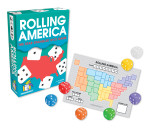 Each player in Rolling America receives their own copy of a very abstract map of the United States. The country is split into six different colored areas, and the game comes with six matching colored dice and one white one. The active player removes two dice from a bag and rolls them. All players must, if possible, assign the appropriate value of the dice on their board in the appropriate area. Thus, if a red six and green three are rolled, a player must put a six somewhere in the red area and a three somewhere in the green area. White dice rolled are “wild” and can be put anywhere on one’s map. The one significant rule is that adjoining “states” must vary by only a value of 1. (ie. a 5 could border a 4 or 6, but not a 2.) If it is impossible to place a number on one’s board, an X is placed in the appropriate color. This continues until almost the entire board is filled. At the end of the game, the player with the fewest X’s wins the game. In addition to planning ahead and a little luck, a strategic player can make good use of three special powers, each usable three times in a game. A player may duplicate a die, change the color of a die, or make a space immune to the border rule, effectively making that spot a “wild card” for the rest of the game. Since the map is rather abstract it isn’t going to teach too much geography, but the game is small, portable, and a blast to play. Technically, since everyone is just putting in the numbers from the same dice, there is no real maximum number of players. I’ve played the game with several different types of gamers and all have appreciated the fun value of such a short (and inexpensive) game.
Each player in Rolling America receives their own copy of a very abstract map of the United States. The country is split into six different colored areas, and the game comes with six matching colored dice and one white one. The active player removes two dice from a bag and rolls them. All players must, if possible, assign the appropriate value of the dice on their board in the appropriate area. Thus, if a red six and green three are rolled, a player must put a six somewhere in the red area and a three somewhere in the green area. White dice rolled are “wild” and can be put anywhere on one’s map. The one significant rule is that adjoining “states” must vary by only a value of 1. (ie. a 5 could border a 4 or 6, but not a 2.) If it is impossible to place a number on one’s board, an X is placed in the appropriate color. This continues until almost the entire board is filled. At the end of the game, the player with the fewest X’s wins the game. In addition to planning ahead and a little luck, a strategic player can make good use of three special powers, each usable three times in a game. A player may duplicate a die, change the color of a die, or make a space immune to the border rule, effectively making that spot a “wild card” for the rest of the game. Since the map is rather abstract it isn’t going to teach too much geography, but the game is small, portable, and a blast to play. Technically, since everyone is just putting in the numbers from the same dice, there is no real maximum number of players. I’ve played the game with several different types of gamers and all have appreciated the fun value of such a short (and inexpensive) game.
Star Wars Bop-it (1+p, $15, 5 min)
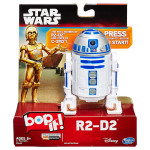 Bop-it, is that funny shaped toy that requires one to “Bop-it”, “Twist-it”, or “Pull-it” in quick succession according to its rapid-fire instructions. The game is back in the form of a cute little R2-D2 figurine where you bop its head, twist its head, or pull its legs (yes, you heard me…) The toy feels very solid and is actually a pretty good figurine in its own right. Bop-it is a fun little game and having it centered around a cute droid just adds to the fun. I highly recommend it as long as you aren’t going to be annoyed at the constant play. Its one main detraction is the voice on the figure. It is a rather poor version of C3-PO’s voice. This is rather disconcerting coming from a cute R2D2 droid, and it comes across as rather whiny. Despite the voice work, the toy is a great gift for a Star Wars fan. If they don’t mind the voice it’s a great little stress reliever, and if they do mind, it still makes a great desk toy.
Bop-it, is that funny shaped toy that requires one to “Bop-it”, “Twist-it”, or “Pull-it” in quick succession according to its rapid-fire instructions. The game is back in the form of a cute little R2-D2 figurine where you bop its head, twist its head, or pull its legs (yes, you heard me…) The toy feels very solid and is actually a pretty good figurine in its own right. Bop-it is a fun little game and having it centered around a cute droid just adds to the fun. I highly recommend it as long as you aren’t going to be annoyed at the constant play. Its one main detraction is the voice on the figure. It is a rather poor version of C3-PO’s voice. This is rather disconcerting coming from a cute R2D2 droid, and it comes across as rather whiny. Despite the voice work, the toy is a great gift for a Star Wars fan. If they don’t mind the voice it’s a great little stress reliever, and if they do mind, it still makes a great desk toy.
Role Playing Games
Role Playing Games have surged in popularity in the past couple of years. If someone in your life shows a leaning towards imagination, creativity, or storytelling, an introduction to the world of role playing games might be in order. Here are a few examples spanning a wide variety of types and recommended ages.
Star Wars RPG ($60 rulebook, $30 beginner box)
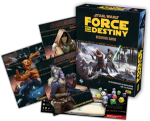 With the new movie appearing, all things Star Wars are rather “the hotness” right now. Those wanting to create their own adventures in the Star Wars universe can look no farther than the Star Wars RPG published by Fantasy Flight Games. All that is needed to play is a core rulebook and some of the specialized dice. There are three versions of the core rulebook, all compatible with each other. Edge of the Empire specializes in the grey area of black markets and smuggling (although it does contain the rules for playing a droid), Age of Rebellion focuses in the struggle of the Rebellion against the Empire, and the newest book, Force and Destiny, brings in all the variations of Force users into the game. Gamers can use one, all three, or pick and choose among them to create their own Star Wars adventures. I highly recommend checking out the Beginner Box available for each version, which is a great value. The Beginner box contains a set of the specialized dice, premade characters and a couple of adventures designed to slowly introduce players to the rules of the game. After playing through the beginner box offerings (a few play sessions), gamers will know if they want to jump into the full game (and you’ll already have some of the dice.)
With the new movie appearing, all things Star Wars are rather “the hotness” right now. Those wanting to create their own adventures in the Star Wars universe can look no farther than the Star Wars RPG published by Fantasy Flight Games. All that is needed to play is a core rulebook and some of the specialized dice. There are three versions of the core rulebook, all compatible with each other. Edge of the Empire specializes in the grey area of black markets and smuggling (although it does contain the rules for playing a droid), Age of Rebellion focuses in the struggle of the Rebellion against the Empire, and the newest book, Force and Destiny, brings in all the variations of Force users into the game. Gamers can use one, all three, or pick and choose among them to create their own Star Wars adventures. I highly recommend checking out the Beginner Box available for each version, which is a great value. The Beginner box contains a set of the specialized dice, premade characters and a couple of adventures designed to slowly introduce players to the rules of the game. After playing through the beginner box offerings (a few play sessions), gamers will know if they want to jump into the full game (and you’ll already have some of the dice.)
ICONS RPG ($15 base rules, supplements and tools for $6+)
![]() If Star Wars isn’t your thing, this year I’ve stumbled across the superhero RPG called ICONS. Available as a PDF on the DriveThruRPG web site, the ICONS system is a fast-playing superhero system that tries to emulate what you would find in a comic book. Player actions are even broken down into “Panels” while one round of all players taking an action is called a “Page.” In all, the game is fairly rules-light to provide a flexible, fast paced game for all involved. One aspect intrigues me, standard character creation is randomly generated by rolling dice. Of course, groups are free to adapt things to be more or less randomized, but I enjoy the challenge of rolling up a unique character and then seeing where it takes me.
If Star Wars isn’t your thing, this year I’ve stumbled across the superhero RPG called ICONS. Available as a PDF on the DriveThruRPG web site, the ICONS system is a fast-playing superhero system that tries to emulate what you would find in a comic book. Player actions are even broken down into “Panels” while one round of all players taking an action is called a “Page.” In all, the game is fairly rules-light to provide a flexible, fast paced game for all involved. One aspect intrigues me, standard character creation is randomly generated by rolling dice. Of course, groups are free to adapt things to be more or less randomized, but I enjoy the challenge of rolling up a unique character and then seeing where it takes me.
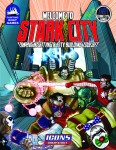 If the game takes your fancy, the DriveThruRPG site has a wealth of inexpensive expansions and supplements available. Those wanting just and introduction can check out an older edition of the rules on a “pay what you want” basis. Of note is the Stark City setting which has both a full fledged city full of characters and plotlines, but also includes a book of advice and help in designing your own cities to best fit the players’ characters. While character creation is very quick and easy, there is even a character generation computer program (for most platforms) to make it even faster and easier. Due to its black and white good guy/bad guy style of play, I am a fan of superhero role playing. ICONs is a great system for a more freestyle type of superhero role playing.
If the game takes your fancy, the DriveThruRPG site has a wealth of inexpensive expansions and supplements available. Those wanting just and introduction can check out an older edition of the rules on a “pay what you want” basis. Of note is the Stark City setting which has both a full fledged city full of characters and plotlines, but also includes a book of advice and help in designing your own cities to best fit the players’ characters. While character creation is very quick and easy, there is even a character generation computer program (for most platforms) to make it even faster and easier. Due to its black and white good guy/bad guy style of play, I am a fan of superhero role playing. ICONs is a great system for a more freestyle type of superhero role playing.
Conclusions
No matter what toys and presents the holidays bring, be sure to keep time in your schedule for playing with friends and family. While the games here come highly recommended to provide fun for a wide range of players, there are plenty other choices available. Ask your local game store, check some of our past recommendations, or swing by the BoardGameGeek Gift Guide for 2015.





Discussion Area - Leave a Comment